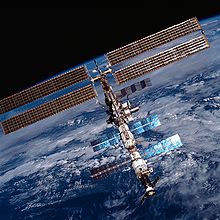
Summary
Night Glider mode (or "XVV Night Glider mode"[1]) is one of the procedures for orienting the solar arrays on the International Space Station.

Normally the photovoltaic solar arrays of the space station track the sun. However, one of the main causes of orbital decay on the space station is that the area of the solar arrays, brushing against the thin residual atmosphere at orbital altitude, results in a small amount of aerodynamic drag. The drag can be lowered by orienting the solar arrays in "sun slicer" mode, where they fly edge-on to the orbital direction, rather than tracking the sun, however, this orientation reduces the power produced. The "night glider" mode is a hybrid orientation,[2] where the solar arrays track the sun during the period when the space station is illuminated, are rotated edge-on to the orbital direction when it enters in the Earth's shadow, and then are returned to their tracking position when the station re-enters sunlight.[3] This reduces the average drag on the station's solar arrays by about 30 percent, with no reduction in power.
Use of night-glider mode had been proposed at NASA Lewis early in the space station's history,[2] but was only implemented in 2003,[4] after the Space Shuttle Columbia disaster, when the ability of the Space Shuttle to bring propellant to the station for orbital maintenance was removed while the Space Shuttle program went through a period of redesign.[5] The implementation of drag-reducing flight modes of the space station resulted in saving about 1,000 kg of orbital-maintenance propellant per year.[6]
A different operational mode, sun slicer drag-reduction, is also sometimes used; in sun slicer mode, the arrays are oriented edge-on to the direction of travel for the full orbit. In this mode, the drag is minimized, however, the power output is reduced from the full power available. Operationally, it is sometimes desirable to orient the solar arrays to produce the opposite effect, and maximize the drag on the arrays. This may be done, for example, to reduce the space station orbital altitude in order to reduce the amount of fuel required for the shuttle to reach the space station. Choosing which solar array orientation mode is used is a function of ISS operations ("mission control").
See also edit
References edit
- ^ J. Bacon, "XVV Night Glider," pp. 85, Space Flight 101, Document 2006-0047636, NASA Johnson Space Center, Houston, TX, Jan. 1, 2006. Retrieved 21 February 2018.
- ^ a b G. Landis and C-Y Lu, "Solar Array Orientation Options for a Space Station in Low Earth Orbit", Journal of Propulsion and Power, Vol. 7 No. 1, 123-125 (1991).
- ^ R. Dana, "Solar in Space: Powering the International Space Station", Solar Tribune, August 7, 2017. Retrieved 21 February 2018.
- ^ see NASA Space Station ISS On-Orbit Status Reports, starting with 11 March 2003 and following reports through 2004
- ^ NASA Explores article: "Station Without Shuttle"
- ^ Lindy Fortenberry, Kathy Laurini, John-David F. Bartoe, and Bill Gerstenmaier, NASA Johnson Space Center, "Continuing the Journey on the International Space Station," paper IAC-03-T.1.02, 54th IAF Congress, Bremen Germany (2003)
External links edit
- A tutorial on space station operation fundamentals: J. Bacon, Space Flight 101, (2006), pp. 81–92. See NASA Scientific and Technical Aerospace Report, V. 44, issue 21, p. 12 (2006).
- Overview of night-glider mode: NASA Glenn Research Center, "Change in Solar Array Orientation Successfully Reduced ISS Propellant Usage," Research and Technology 2006, NASA TM-2007-214479, pp. 118–119 (2007).
- International Space Station (ISS) power supply information at Aviation Spectator


